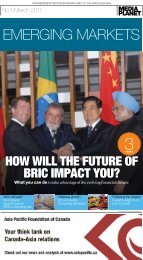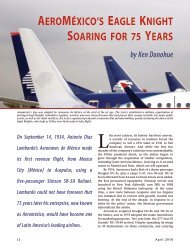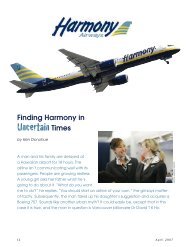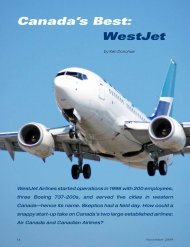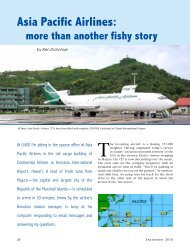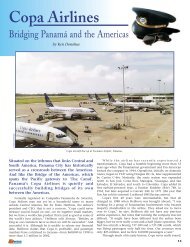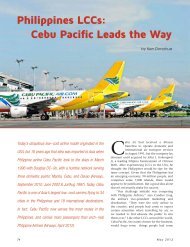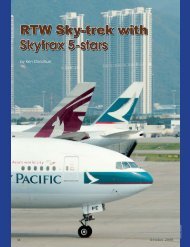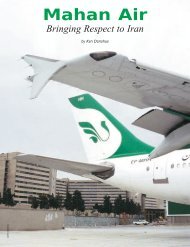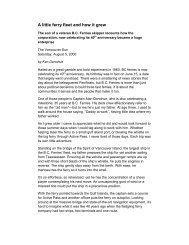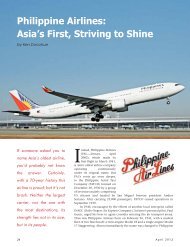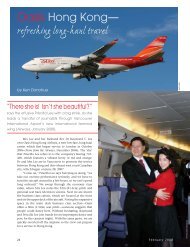Taiwan Taoyuan Seeks Success - Ken Donohue
Taiwan Taoyuan Seeks Success - Ken Donohue
Taiwan Taoyuan Seeks Success - Ken Donohue
You also want an ePaper? Increase the reach of your titles
YUMPU automatically turns print PDFs into web optimized ePapers that Google loves.
<strong>Taiwan</strong> <strong>Taoyuan</strong> <strong>Seeks</strong> <strong>Success</strong><br />
by <strong>Ken</strong> <strong>Donohue</strong><br />
KEN DONOHUE<br />
TPE’s Terminal 2, opened in 2000, and the air traffic control tower.<br />
When <strong>Taiwan</strong> <strong>Taoyuan</strong> International Airport<br />
(Táiwān Táoyuán Gúojì Jīchǎng—IATA: TPE),<br />
formerly known as Chiang Kai-shek International<br />
(CKS), or Chung-Cheng (Zhongzheng)<br />
International, opened in 1979, it was Asia’s largest<br />
airport. But that was more than 30 years ago, and<br />
history counts for little. In the last 15 years alone,<br />
six new airports have been built in East Asia. And<br />
with a growing list of passenger amenities, these<br />
airports, along with others in the region, are billing<br />
themselves as the perfect hub—linking Asia with<br />
Europe, North America, and Oceania. Can TPE<br />
compete with these ultra-modern airports, some<br />
of which are perennially ranked as the best in<br />
the world? The government of <strong>Taiwan</strong> thinks so,<br />
which is why it is investing billions of dollars over<br />
the next 20 years to position <strong>Taiwan</strong> <strong>Taoyuan</strong> as an<br />
airport of choice for airlines and their passengers.<br />
Previously, Taipei’s airport was Songshan (Táiběi<br />
Sōngshān Jīchǎng—TSA), located within the city<br />
limits of Taipei, and built originally as an air base<br />
during Japanese occupation in 1936. Following<br />
World War II, the airfield was taken over by the Republic<br />
of China Air Force, and in 1950 became a joint militarycivilian<br />
aerodrome. With a move to a manufacturing<br />
and export-led economy, <strong>Taiwan</strong> experienced explosive<br />
growth through the Seventies and Eighties. This created<br />
increased demand for air travel, for both passengers and<br />
cargo. It also meant that Songshan became overcrowded.<br />
With a single runway and a night-time curfew, and the<br />
city quickly expanding around it, expansion of the airport<br />
was not practical. Thus, a new international airport, one<br />
of ten major construction projects undertaken by the<br />
<strong>Taiwan</strong>ese government, was built.<br />
Located 31km (18mi) west from Taipei City, near the<br />
northern coast of <strong>Taiwan</strong>, the new airport was built with<br />
parallel runways. Known today as Terminal 1, the sole<br />
terminal building was modeled on that of Washington<br />
46<br />
September 2012
a<br />
M<br />
e d<br />
i t e r r<br />
Dulles, and featured 22 gates, 11 of which were<br />
located on the north concourse, with the other<br />
half positioned on the south concourse. The core<br />
building is located between these two concourses,<br />
and together they form a large ‘H’. But as with<br />
many growing cities, the complex reached its<br />
capacity in only ten years, so a second passenger<br />
terminal was added.<br />
Terminal 2, with a similar layout, opened in<br />
2000, though initially only the gates on the south<br />
concourse were used. The northern gates became<br />
operational five years later. EVA Air (Chángróng<br />
Hángkōng; BR/EVA—Airways February 2011 &<br />
December 1999), <strong>Taiwan</strong>’s first private international<br />
airline, was the first carrier to operate out of T2.<br />
China Airlines, <strong>Taiwan</strong>’s largest airline (see page 22),<br />
uses both T1 and T2, with most long-haul flights to<br />
Europe and North America operating from T2 while<br />
T1 handles East Asian destinations. Two ‘Skytrain’<br />
people mover lines on opposite sides of the airport<br />
whisk travellers between the two terminals.<br />
Aircraft at the north concourse gates almost<br />
exclusively use the north runway (05/23), while 06/24<br />
n<br />
Rome<br />
e a n S e<br />
Milan<br />
a<br />
Prague<br />
Warsaw<br />
St Peterburg<br />
Budapest BELARUS<br />
Moscow<br />
Ankara<br />
TURKEY<br />
UKRAINE<br />
Sofiya MOLDOVA<br />
Bucharest<br />
Istanbul<br />
Lahore<br />
P AKIST AN<br />
KAZAKHSTAN<br />
UZBEKISTAN<br />
Cairo LEBANON<br />
SYRIA<br />
ISRAEL<br />
JORDAN<br />
TURKMENISTAN<br />
KYRGYZSTAN<br />
Baghdad Tehran<br />
IRAQ<br />
TAJIKISTAN<br />
I R A N AFGHANISTAN<br />
KUWAIT<br />
R e d S e a<br />
SAUDI<br />
ARABIA<br />
YEMEN<br />
UANIA<br />
LATVIA<br />
USSIA<br />
B l a c k S e a<br />
Gulf of<br />
Aden<br />
IA<br />
Volgograd<br />
QATAR<br />
UNITED<br />
ARAB<br />
EMIRATES<br />
OMAN<br />
C a s p i a n S e a<br />
Aral<br />
Sea<br />
Karachi<br />
A r abian<br />
Sea<br />
Bombay<br />
I N D I A<br />
SRI<br />
LANKA<br />
serves those on the opposite side of the terminal.<br />
Two taxiways allow aircraft to transit between the<br />
north and south sides. TPE experiences two busy<br />
Delhi<br />
Hyderabad<br />
Colombo<br />
Madras<br />
I N D I A N<br />
O C E A N<br />
Lensk<br />
R U S S I A<br />
RUSSIA<br />
MONGOLIA<br />
CHINA<br />
BURMA<br />
LAOS<br />
THAILAND<br />
CAMBODIA<br />
VIETNAM<br />
MALAYSIA<br />
SINGAPORE<br />
Beijing<br />
Sea of<br />
Okhotsk<br />
NORTH<br />
KOREA<br />
SOUTH<br />
KOREA<br />
Hong Kong<br />
Shanghai<br />
T’ai-pei<br />
TAIWAN<br />
PHILIPPINES<br />
INDONESIA<br />
JAPAN<br />
Tokyo<br />
PAPUA<br />
NEW GUINEA<br />
AUSTRALIA<br />
MANUEL NEGRERIE<br />
Unsurprisingly, <strong>Taiwan</strong>’s China Airlines and EVA Air dominate traffic at TPE.<br />
Airways<br />
47
periods each day, from 0600 to 0800, and again<br />
from 1400 to 1600. Most flights from North<br />
America arrive early in the morning, allowing for<br />
onward connections throughout Asia, returning<br />
to Canada and the USA that evening.<br />
Both industry and government officials in<br />
<strong>Taiwan</strong> recognize that TPE, the island’s largest<br />
airport and main international gateway, is<br />
lagging behind others in the region. But because<br />
of land and cost constraints a new airport in<br />
Taipei is not being considered. Instead, a massive<br />
expansion of the existing airport, including a<br />
third runway, a larger cargo area, and a another<br />
passenger terminal, are planned.<br />
A Skytrain moves travellers between T1 (pictured) and T2.<br />
Fueling traffic growth is improved relations<br />
between the Republic of China (<strong>Taiwan</strong>’s official<br />
name) and the People’s Republic of China (PRC).<br />
In recent years, China and <strong>Taiwan</strong> have allowed<br />
more nonstop flights between the two sides.<br />
Today, more than 40 cities in mainland China are<br />
served from Taipei, with the number expected to<br />
grow in coming years.<br />
In addition, a preferential trade agreement<br />
between <strong>Taiwan</strong> and China was signed in 2010,<br />
increasing both business and leisure travel across<br />
the <strong>Taiwan</strong> Strait. To underscore how significant<br />
this market is to the airport, four years ago—the<br />
first year scheduled flights were allowed—the<br />
number of arrivals from cities in mainland China<br />
was only 320,000. In 2011, that number had<br />
soared to nearly two million. Both China Airlines<br />
and EVA Air are bullish about the future of crossstrait<br />
traffic, and on most routes employ widebody<br />
aircraft to meet demand.<br />
100 flights a week.<br />
Cathay Pacific Airways is the third largest airline at Taipei, operating more than<br />
While the number of travellers arriving from<br />
mainland China cities continues to increase,<br />
Hong Kong and, to a lesser extent, Macau still<br />
represent the largest destinations to and from<br />
Taipei. Combined, those two cities provide<br />
almost 25% of the airport’s total traffic. And not<br />
surprisingly, Hong Kong’s Cathay Pacific Airways<br />
has the greatest presence of any overseas carrier<br />
at Taipei.<br />
The original T1 is undergoing a major $57<br />
million renovation, which when complete by the<br />
end of this year will have the look of a brand-new<br />
building. Gone is the Dulles lookalike. Designed<br />
by Japanese architect Norihiko Dan, the exterior<br />
of the building draws its architectural influence<br />
from East Asian culture, with a long, sloping<br />
roof. The renovated interior will add 196,000m 2<br />
(2.1 million sq ft) of space, enough for an annual<br />
flow of three million more passengers, with—<br />
naturally—an enlarged shopping area.<br />
The planning process for what will be known<br />
as Terminal 3, including an environmental impact Check-in area, Terminal 2.<br />
TIAC<br />
MANUEL NEGRERIE<br />
KEN DONOHUE<br />
48<br />
September 2012
The Hello Kitty lounge in T2, and the startling Hello Kitty self check-in area.<br />
The lobby of the Novotel, some of whose rooms have excellent views over the runways.<br />
KEN DONOHUE<br />
MANUEL NEGRERIE<br />
NOVOTEL<br />
assessment and design phase, is currently<br />
underway, with construction expected to<br />
begin in 2014. This $2 billion structure<br />
is anticipated to be operational in 2018,<br />
and will bring the airport’s total annual<br />
capacity to 60 million passengers. A<br />
satellite terminal will also be constructed<br />
with the potential for 64 additional gates.<br />
And by 2030, the airport’s new layout is<br />
expected to be complete, with a third<br />
runway located north of the existing<br />
Runway 05/23.<br />
Sensibly, access is also being<br />
improved with a $97 million Mass Transit<br />
Railway from Taipei’s city station. When<br />
completed in 2013, the journey to the<br />
airport will take 35 minutes, compared<br />
to 50 minutes by bus or car. Departing<br />
passengers will be able to check bags at the<br />
city station, and proceed directly to the<br />
boarding gates upon arrival at the airport.<br />
While the rail link will offer a convenient<br />
option for travellers, ironically it was<br />
inauguration of the country’s high-speed<br />
train line that all but killed domestic air<br />
service. Formerly there were several small<br />
airlines connecting cities on the 395km<br />
(245mi)-long island, but with the train<br />
taking less than two hours to travel from<br />
north to south, flying no longer makes<br />
sense. Now there are only a handful of<br />
domestic flights, most serving <strong>Taiwan</strong>’s<br />
offshore islands (Airways, February 2011).<br />
While TPE faces stiff competition<br />
from others in the region, it is taking the<br />
steps to develop into a true transit hub.<br />
“This huge investment in infrastructure<br />
that we are seeing today will better<br />
position the airport to achieve this goal,”<br />
says Yuan-hung Ting, a senior business<br />
planning specialist for the <strong>Taoyuan</strong><br />
International Airport Corporation,<br />
pointing out that Taipei is geographically<br />
well situated to serve southeast and<br />
northeast Asia. But the airport authority<br />
knows that geography counts for only so<br />
much. “We need to develop the airport as<br />
a choice for people to land,” admits Ting.<br />
“Singapore offers a swimming pool and<br />
showers, so we need to elevate passenger<br />
amenities so people will choose Taipei.”<br />
On previous visits, the airport<br />
looked drab and run-down. Now, it’s<br />
hardly recognizable. And much of that<br />
credit goes to Ever Rich Duty Free. More<br />
than just an airport retailer, Ever Rich<br />
Airways<br />
49
completed the remodeling in the<br />
airside area without government<br />
financing, and has changed the face<br />
of the airport’s public services areas.<br />
Four waiting lounges have<br />
been created, including a quiet,<br />
relaxation area with complimentary<br />
massage chairs and surrounded by<br />
trees and plants. Another is the<br />
brightly colored Hello Kitty area,<br />
while another, the e-library, is an<br />
acknowledgment of <strong>Taiwan</strong>’s hightech<br />
industry. Here, a recharging<br />
station allows you to lock up your<br />
electronic device and charge it<br />
while you explore the rest of the<br />
airport. And it’s often the little<br />
things that make a difference in a<br />
passenger’s experience—such as<br />
the brightly colored nursing room<br />
that serves as a comfortable retreat<br />
for mothers to tend to their babies,<br />
with complimentary diapers and<br />
other supplies.<br />
The China Airlines-owned Novotel at Taipei <strong>Taoyuan</strong> International Airport is five minutes<br />
from the airport and adjacent to the Chung Cheng Aviation Museum, built in 1981 by Boeing.<br />
Complimentary buses also run between the airport and the museum, which displays a number<br />
of aircraft, including this Grumman HU-16 Albatross.<br />
KEN DONOHUE<br />
Located in Terminal 2, the <strong>Taiwan</strong> Green Wall is an outline<br />
of the island formed by 3,000 varieties of seasonal plants,<br />
which help to purify the air inside the building.<br />
PHOTOS: KEN DONOHUE<br />
Staffed information desks, and roaming information<br />
consultants, are strategically located to assist passengers. Free<br />
Wi-Fi access is available throughout TPE, unlike the situation<br />
at many other major airports. While the shops here are filled<br />
with the usual international brands, Ever Rich has made a<br />
commitment to showcase a vast array of <strong>Taiwan</strong>ese products,<br />
including teas, foodstuffs, and work from local artisans. If you tire<br />
of shopping, you can indulge your senses in an orchid garden,<br />
or an art gallery that displays <strong>Taiwan</strong>ese art; or marvel at the<br />
<strong>Taiwan</strong> Green Wall, a 36m 2 (400sq ft) map of <strong>Taiwan</strong>, made up of<br />
thousands of varieties of living plants. And if you have a lengthy<br />
transit between flights, you can even take a complimentary halfday<br />
city tour.<br />
“We are competing with Hong Kong and Singapore, and<br />
so our goal is to create a better experience,” says Sharol Yeh,<br />
the company’s manager of airport operations. “We need more<br />
passengers, but the government is doing a good job at making<br />
the aviation industry a priority.”<br />
Indeed it is. Aside from massive redevelopment, the<br />
government has also committed to creating an ‘airport city’. The<br />
first step in that bold plan was for China Airlines to relocate its<br />
corporate office and operations center, known as CAL Park, to<br />
the airport.<br />
This included the construction of a 360-room hotel<br />
owned by China Airlines, but operated by the internationally<br />
recognized Novotel brand. Only a few minutes from the<br />
terminals, accommodation is four-star. For aviation aficionados,<br />
some rooms offer fantastic views of both runways. As the closest<br />
hotel to the airport, it is already convenient, but will become<br />
even more so in a year’s time when the airport–city MTR line is<br />
complete, as one of the stations will be at the hotel.<br />
50<br />
September 2012
Located next to the hotel is the Chung Cheng<br />
Aviation Museum, with a wide array of displays<br />
and aircraft that celebrate <strong>Taiwan</strong>’s military<br />
and civilian aviation history. A small, enclosed<br />
observation area is located above the museum,<br />
affording excellent views of aircraft movements<br />
on Runways 05 & 06.<br />
Given <strong>Taiwan</strong>’s geographic location and<br />
highly developed manufacturing and export<br />
economy, it isn’t surprising that Taipei is a large<br />
cargo hub, ranking in the top 20 worldwide for<br />
cargo volume. TPE is served by two air cargo<br />
terminals. The largest, and handling about 45%<br />
of <strong>Taoyuan</strong>’s cargo, is <strong>Taiwan</strong> Air Cargo Terminals<br />
Ltd (TACTL). Founded in 1999 and majorityowned<br />
by the China Airlines Group, its terminal<br />
occupies more than 130,000m 2 (1.4 million sq<br />
ft) of space, and is equipped with 12 freighter<br />
parking spaces. The other cargo terminal is<br />
operated by the Evergreen Group (parent of<br />
EVA Air), which established the Evergreen Air<br />
Cargo Services Corporation in 2000, and is<br />
well integrated into Evergreen’s global air, sea,<br />
and land transport network. Currently more<br />
than 1.6 million tonnes (3.5 billion lb) of cargo<br />
are handled at the airport, and the volume is<br />
expected to triple in the next two decades. To<br />
accommodate this growth, redevelopment plans<br />
for the airport include an expanded cargo zone at<br />
the north end of the airport.<br />
Can <strong>Taiwan</strong> <strong>Taoyuan</strong> International Airport compete with<br />
the likes of Hong Kong International Airport, Seoul-Incheon,<br />
or Singapore’s Changi? Time will be the judge. But if will is any<br />
indication—the will to improve the airport’s infrastructure, and<br />
the will to create a better passenger experience—then surely the<br />
airport will succeed. ✈<br />
Fast Facts<br />
<strong>Taiwan</strong> <strong>Taoyuan</strong> International Airport<br />
臺 灣 桃 園 國 際 機 場<br />
桃 園 機 場<br />
IATA: TPE<br />
Location:<br />
(Táiwān Táoyuán Gúojì Jīchǎng)<br />
ICAO: RCTP<br />
Traffic (2011)<br />
Passengers: 24,947,551<br />
Cargo (tonnes):<br />
1.6 million<br />
Aircraft movements: 163,199<br />
16.7nm (30.9km) west of Taipei City<br />
Formally opened: February 26, 1979<br />
Owner:<br />
Operator:<br />
Website:<br />
Government of the Republic of China<br />
<strong>Taoyuan</strong> International Airport Corporation<br />
www.taoyuan-airport.com<br />
TWCAA<br />
Airways<br />
51



